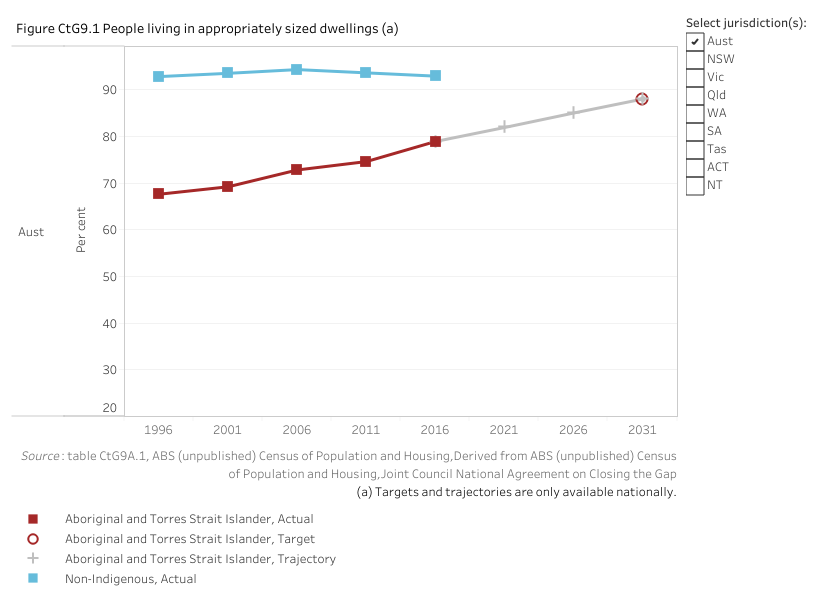TARGET 9
By 2031, increase the proportion of Aboriginal and Torres Strait Islander people living in appropriately sized (not overcrowded) housing to 88 per cent
Dashboard snapshot: The data below are the most recent at the time of preparing the July 2021 report. Please go to the dashboard to access the current data.
Nationally in 2016, 78.9 per cent of Aboriginal and Torres Strait Islander people were living in appropriately sized (not overcrowded) housing (figure CtG9.1).
There are no new data since the baseline year of 2016.

Target data specifications
Outcome: | Aboriginal and Torres Strait Islander people secure appropriate, affordable housing that is aligned with their priorities and need. |
|---|---|
Target: | By 2031, increase the proportion of Aboriginal and Torres Strait Islander people living in appropriately sized (not overcrowded) housing to 88 per cent. |
Indicator: | The proportion of Aboriginal and Torres Strait Islander people living in appropriately sized (not overcrowded) housing. |
Measure: | The measure is defined as: Numerator — number of Aboriginal and Torres Strait Islander people living in appropriately sized (not overcrowded) dwellings Denominator — total number of Aboriginal and Torres Strait Islander people and is presented as a percentage. |
Target established: | National Agreement on Closing the Gap July 2020 |
Latest dashboard update: | 23 June 2021 |
Indicator type: | Target |
Interpretation of change: | A high or increasing proportion is desirable. An increase from the baseline year is an improvement. |
Data source(s): | Name: Census of Population and Housing Frequency: Five-yearly Documentation (links): https://www.abs.gov.au/census |
Data provider: | Provider name: Australian Bureau of Statistics Provider area: Census |
Baseline year: | 2016 |
Target year: | 2031 |
Disaggregations: | State and territory and Australia, by Indigenous status. |
Computation: | Numerator divided by Denominator multiplied by 100 Counting rules Data are for people enumerated in private dwellings who reported being ‘at home’ on Census night. Geographical variables are based on a person's Place of Usual Residence. Numerator Appropriately sized dwellings are those where no extra bedrooms are required to adequately house the usual residents, using the criteria of the Canadian National Occupancy Standard (CNOS). The CNOS specifies that:
The CNOS requires knowledge of the age, sex and relationship status of all tenants within a household, as well as the number of bedrooms in the dwelling. Households for which complete dwelling utilisation information is not available are excluded from this measure. Includes (numerator and denominator):
Excludes (numerator and denominator):
Extraction Census Table Builder (Pro) – HOSD x INGP x Main ASGS (UR) x UAICP |
Data quality considerations: | Data values have been randomly adjusted using perturbation to avoid the release of confidential data. There is no universally accepted definition of what constitutes an overcrowded household. The ABS uses the CNOS. The CNOS is widely used in Australia and internationally. The relevance and appropriateness of CNOS in depicting dwelling utilisation for Aboriginal and Torres Strait Islander people has not been assessed. |
Future reporting: | Additional disaggregations required for future reporting:
|
Supporting indicators
Driver
- Change in population by location
- Change in social housing dwellings by location
Contextual information
- Home ownership rate
Including by location and tenure type - Homelessness rate including by type and age group
e.g. Transitional housing/sleeping rough - Structural problems including functional health hardware
Australian Bureau of Statistics (ABS) measure of acceptable standard of housing - Low income household experiencing rental stress/mortgage stress
- Social housing dwellings per 100 households by location
- Progress towards parity
